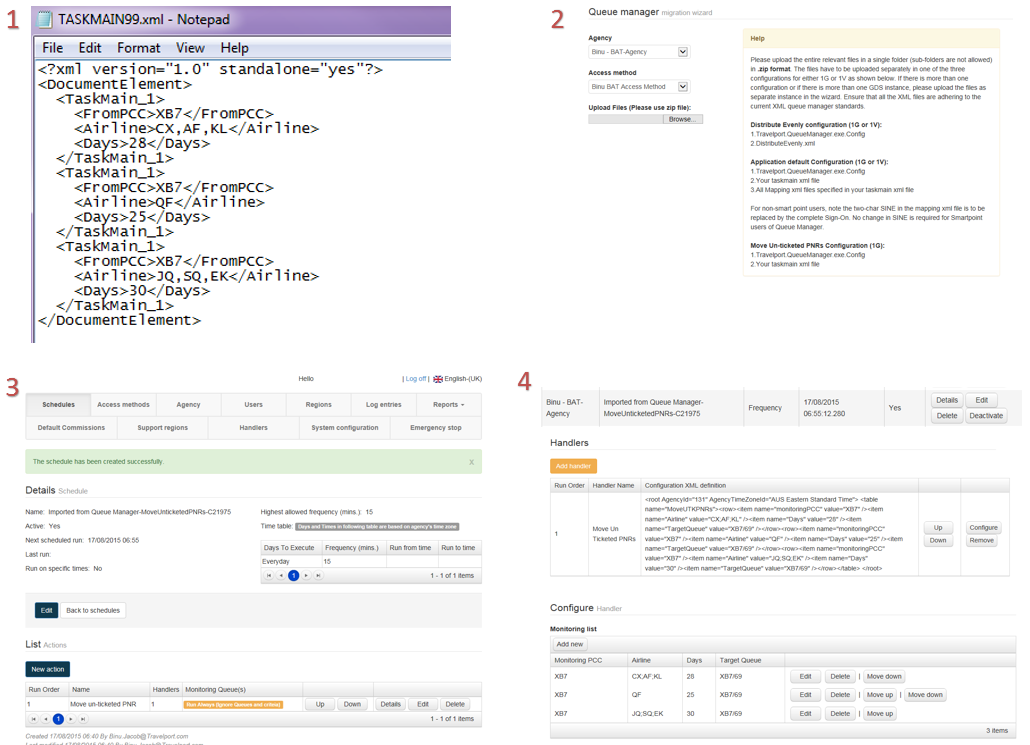Queue Control Migration Wizard Mapping
Worldspan: Not available to Worldspan users.
This section provides information about how the uploaded files are used by Queue Control Console to populate the Queue Control Console database. Refer to Schedules: Queue Manager Migration Wizard for information on the files required for migration.
Reading the XML Queue Manager Configuration File
The XML Queue manager configuration file contains keys which direct the behavior of the application.
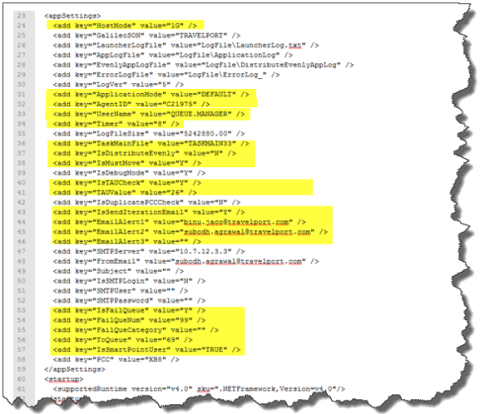
The following table shows the keys in the configuration file and how this information is mapped/used in Queue Control Console:
|
Key |
Queue Control Console Function |
Remarks |
|---|---|---|
|
HostMode |
No direct mapping but is used |
Validates with the host specified in the agency’s access methods. If it does not match, the system throws an error. |
|
GalileoSON |
Not Applicable |
The GWS sign on will be used. |
|
LauncherLogFile |
Not Applicable |
|
|
AppLogFile |
Not Applicable |
|
|
EvenlyAppLogFile |
Not Applicable |
|
|
ErrorLogFile |
Not Applicable |
|
|
LogVer |
Not Applicable |
|
|
ApplicationMode |
No direct mapping but is used |
If this value is “DEFAULT”, the taskmain file is validated to contain the mapping files. If this value contains "UNTICKETED PNR MOVE", the taskmain file must contain the information/format for moving Unticketed PNRs. |
|
AgentID |
No direct mapping but is used |
The agent id is used to suffix the schedule name |
|
UserName |
Mapped to the Received from field for the End Booking handler |
|
|
Timer |
This will be the timing for the scheduler |
Any timer value less than 15 mins will defaulted to 15 mins. |
|
LogFileSize |
Not Applicable |
|
|
TaskMainFile |
The value of the file name will be used and validated to see if it exists in the list of uploaded files. |
The file referred here will be read to map out the actions, criteria, and handlers. |
|
IsDistributeEvenly |
If this value =”Y”, the system checks if DistributeEvenly.xml file exists in the list of uploaded files. If this value =”N”, the system checks the “ApplicationMode” to determine if the taskmain file points to a file for “UNTICKETED PNR MOVE” or “DEFAULT” mode. |
A Distribute PNRs evenly handler in Queue Control Console handles this function. |
|
IsMustMove |
If the value is “Y”, End Booking handler will be configured with ignore and retrieve changes on error option checked. |
|
|
IsDebugMode |
Not Applicable |
Queue Control Console does not run on the client machine and so this option is not relevant |
|
IsTAUCheck |
If the value is “Y”, End Booking handler will be configured. |
|
|
TAUValue |
If the value is “Y”, TAU Check handler will be part of every mapped action of the schedule and TAU Value will be configured. |
TAU check and update handler is available in Queue Control Console. |
|
IsDuplicatePCCCheck |
Not Applicable |
It is assumed that any duplicate PCCs in the taskmain or mapping files are addressed before uploading it into Queue Manager. |
|
IsSendIterationEmail |
Not Applicable |
No email messages are sent when the PNRs are successfully moved to the appropriate queues as per current Queue Control Console functionality. |
|
EmailAlert1 |
Mapped to Unmatched email recipients in action and also mapped to Failure email recipients in Action |
|
|
EmailAlert2 |
Mapped to Unmatched email recipients in action and also mapped to Failure email recipients in Action |
|
|
EmailAlert3 |
Mapped to Unmatched email recipients in Action and also mapped to Failure email recipients in Action |
|
|
SMTPServer |
Not Applicable |
|
|
FromEmail |
Not Applicable |
This function will be available in a subsequent version of Queue Control Console |
|
Subject |
Not Applicable |
|
|
IsSMTPLogin |
Not Applicable |
|
|
SMTPUser |
Not Applicable |
|
|
SMTPPassword |
Not Applicable |
|
|
IsFailQueue |
Failure Queue configuration in Agency |
If this value =Y, the system will make use of the failed and unmatched criteria queue. |
|
FailQueNum |
Map to the Failure Queue number in Agency |
|
|
FailQueCategory |
Map to the Failure Queue category in Agency |
|
|
To Queue |
Value will be used in Move Unticketed PNRs handler |
|
|
IsSmartPointUser |
No direct mapping |
This value is used to validate and determine whether the agent sign-on is the full sign on or the 2-letter sign-on.
|
|
PCC |
Not Applicable |
The GWS sign on will be used. |
Mapping Queue Manager Mapping File to Queue Control Console Criteria
The overall mindmap can be viewed and downloaded as a PDF.
The below table shows the criteria currently used in the mapping files for both 1G and 1V in Queue manager:
|
1G Criteria in Mapping file |
1V Criteria in Mapping file |
Queue Control Console Criteria |
Remarks |
|---|---|---|---|
|
Distributed by SINE |
Distributed by SINE |
|
For non-smart point users, the users must update the current 2-digit SINE value to the agent’s complete SIGN-ON in the mapping XML file. |
|
Distributed by NAME |
Distributed by NAME |
“BookingFile->PhoneNumber contains” |
The value is obtained from the mapping XML file. |
|
Distributed by DI.AC |
Distributed by PT |
For 1G:
For 1V:
|
The value is obtained from the mapping XML file. |
|
Distributed by CI |
Not supported |
“BookingFile->Customer Id contains” |
The value is obtained from the mapping XML file. |
|
Distributed by DI.X |
Not supported |
|
The value is obtained from the mapping XML file. |
Mapping Queue Manager Functions to Schedules, Actions, and Handlers
The mind map in the end of this section illustrates how Queue Control Console maps the schedules, actions, criteria, and handlers depending on the values in the configuration file. The taskmain file and the timer value translates into a schedule.
The schedules imported from Queue Manager are named based on the below logic. Note that in every instance of file upload, there will just one schedule created.
-
If DistributeEvenly (key in configuration file)=”Y” , the schedule name will be as below:
Imported from Queue Manager-DistributePNRsEvenly-<<AgentId>>
So if AgentId is “C21975”, the schedule name will be:
Imported from Queue Manager-DistributePNRsEvenly- C21975 -
If ApplicationMode (key in configuration file)=”Default” and DistributeEvenly=”N”, the schedule name will be as below:
Imported from Queue Manager -<<name of the taskmain file>>- <<AgentId>>
So if AgentId is “C21975” and taskmain file name is “TaskMain1.xml”, the schedule name will be:
Imported from Queue Manager- TaskMain1- C21975 -
If ApplicationMode (key in configuration file)=”UNTICKETED PNR MOVE” and DistributeEvenly=”N”, the schedule name will be as below:
Imported from Queue Manager-MoveUnticketedPNRs - <<AgentId>>
So if AgentId is “C21975”, the schedule name will be:
Imported from Queue Manager-MoveUnticketedPNRs- C21975
Each of the records in the mapping file will correspond to a new action based on the common monitoring queue(s). The action will be named as below:
Move to <<PCC>>/<<Queue>> *<<Category>> by <<queue manager criteria>>=<<criteria value>>
The examples highlighted in green below illustrate the names of action based on the above logic:
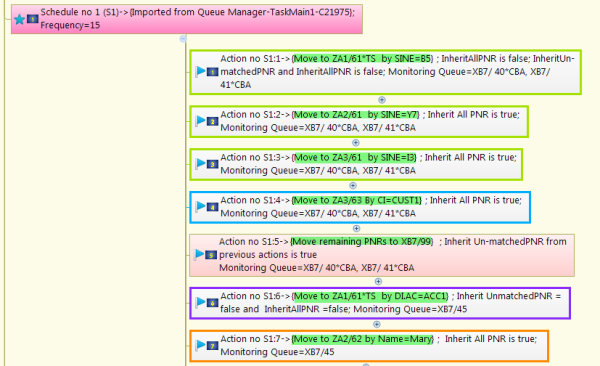
(Note: a snippet from the below mind map)
The first action created for the schedule will not inherit PNR. But for the subsequent actions, which monitor the same queue, the actions will have Inherit All PNR option set to true. These actions will include the criteria available in the mapping file and the relevant handlers as illustrated below:
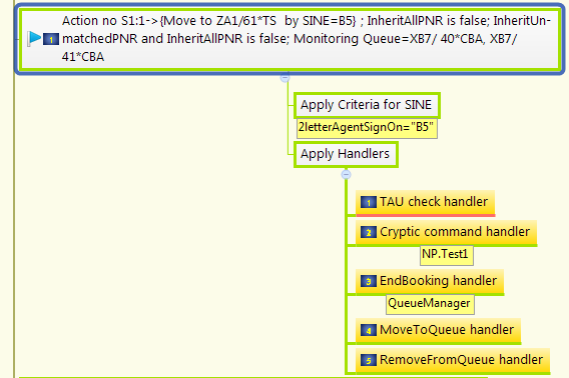
Once all the actions for the monitoring queue is complete, any unmatched PNRs should be moved to the failure queue as specified in the configuration file. For this action, the option to Inherit All Un-matched PNRs from previous actions will be checked.
The hierarchy of handlers for the actions is in the order below:
- TAU Check and Update handler
- Cryptic command handler (as applicable)
- End booking handler
- Move to Queue Handler
- Remove from Queue Handler
This action will be named as:
Move remaining PNRs to << Target PCC>>/<<Target queue>>*<<Target category>>. Refer to the example below in green.

If the records in mapping file (the criteria for moving the PNR) and the cryptic commands are the same but the monitoring queue is different the mapping file records will translate into the same action in Queue Control Console but with as many monitoring queues as is present in the taskmain file for the same mapping file records. The illustration below shows the actions that are monitoring two queues (queue XB7/40*CBA and XB7/41*CBA) for the same set of criteria and handlers corresponding to the similar records in the taskmain and mapping file with monitoring queues being different. The left side represents the taskmain /mapping configuration. The right side represents the Queue Control Console configuration.

New actions are created for taskmain records based on a different monitoring queue and a different criteria or a different notepad entry from the earlier taskmain records as shown below. For these actions, the first action in the series (based on the same monitoring queue will not inherit any PNRs but the subsequent actions will have the InheritAllPNR option set to true. The unmatched PNRs is directed to the failure queue with as mentioned earlier and highlighted in red below.
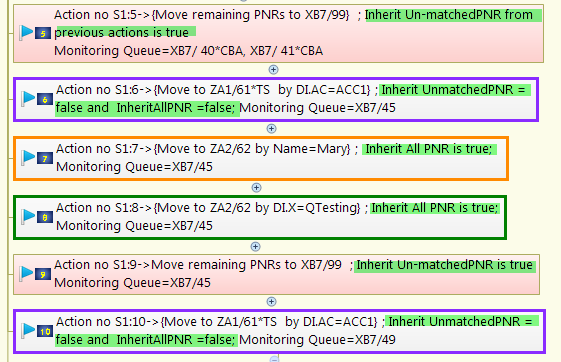
If DistributeEvenly (key in configuration file) =Y, the schedule/actions and handlers created for this scenario is illustrated below. There will be one Distribute PNRs Evenly handler created under one action and one schedule to import this configuration from Queue Manager. The action is named “Distribute PNRs evenly among different queues” with Always run option set to true as it is not monitoring any specific queue.

If ApplicationMode (key in configuration file) =” UNTICKETED PNR MOVE” and DistributeEvenly=”N”, the schedule/actions and handlers created for this scenario is illustrated below. Similar to the DistributePNRsEvenly scenario above, there is one Move un-ticketed PNRs handler created under one action and one schedule to import this configuration from Queue Manager. The action is named “Move un-ticketed PNRs” with Always run option set to true as it is not monitoring any specific queue.

The overall mindmap can be viewed and downloaded as a PDF.
Storyboards for Queue Manager Migration
Queue Manager - Move to Queue - default option
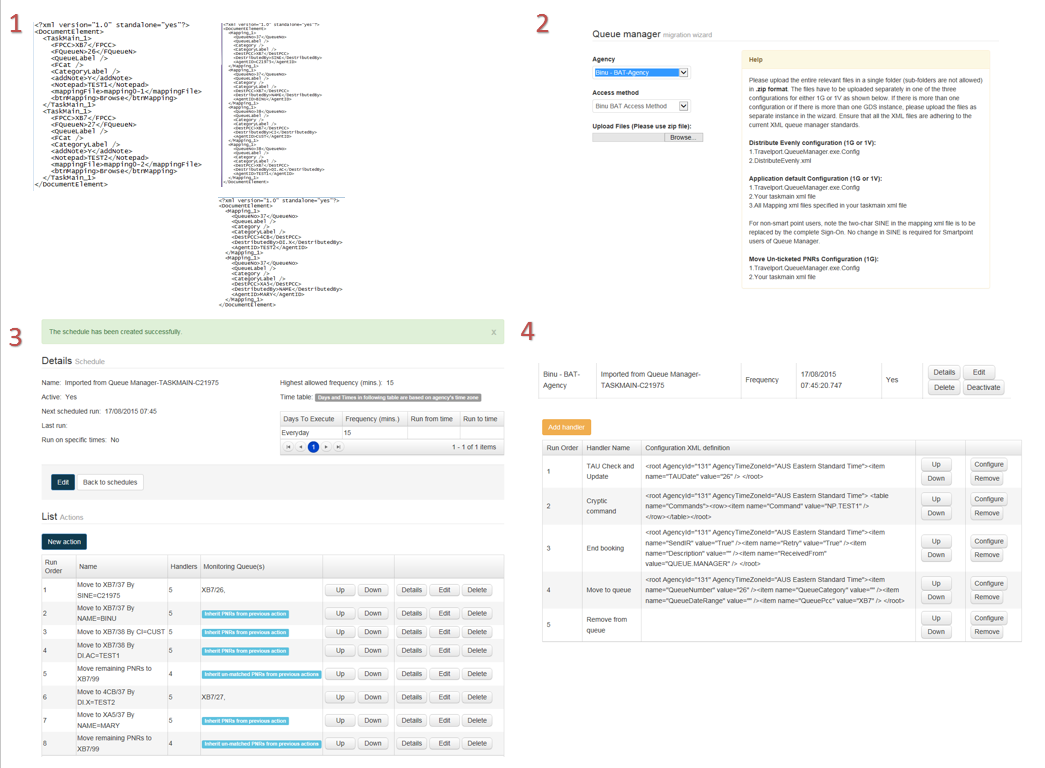
Queue Manager - Distribute evenly option
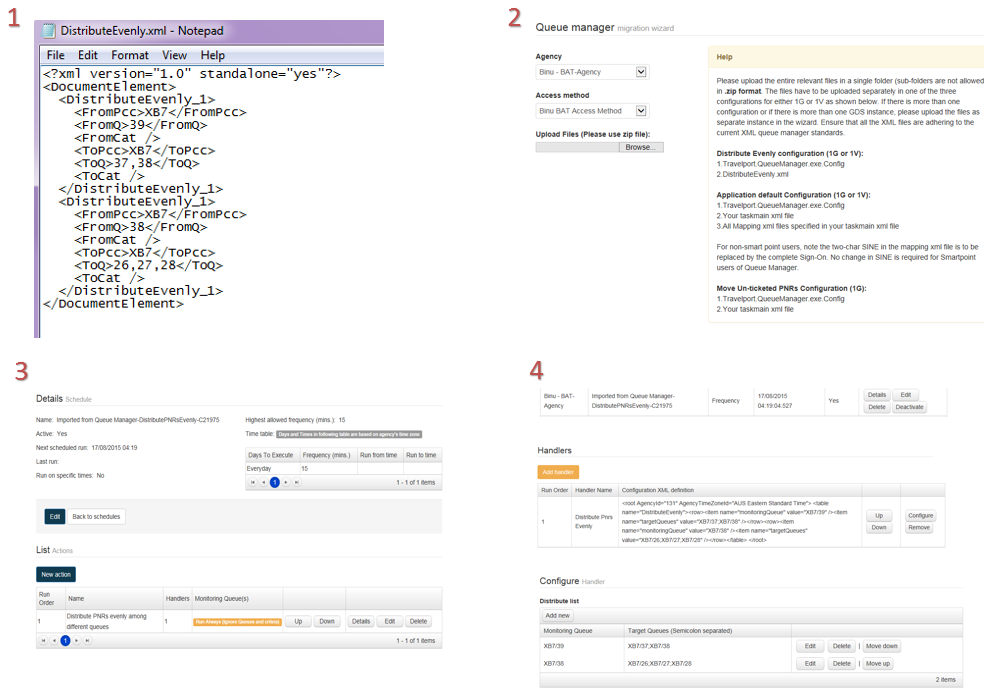
Queue Manager - Move Un-ticketed PNR option
